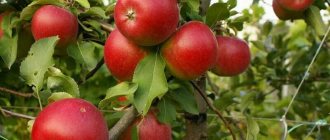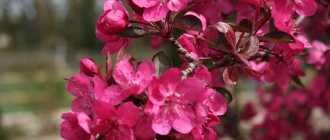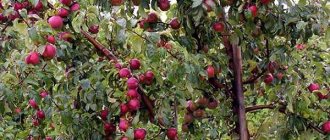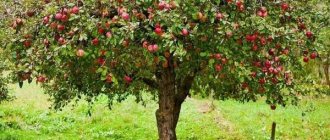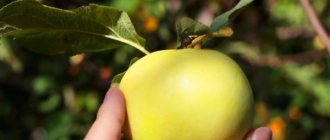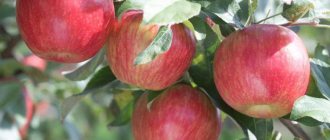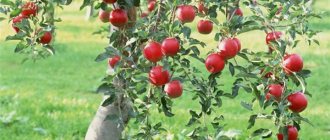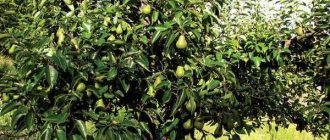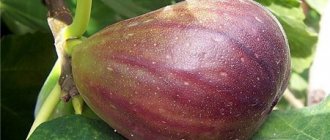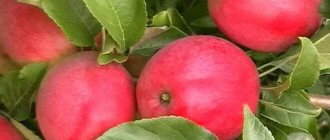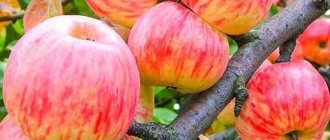- home
- Agronomy
- Autumn apple tree varieties
Elena Golets21 March 2014 8363
With a small plot of land, it is impossible to place all the desired breeds and varieties. Only selected, best breeds and varieties, well tested in local conditions, are selected for planting. Let's introduce the best autumn varieties of apple trees .
Autumn variety of apple tree Parmen winter golden
The autumn variety of apple tree Parmen winter golden is one of the most common autumn varieties, indispensable for industrial and home gardens. It begins to bear fruit at 5-7 years of age, and the harvest grows quickly. On good soils there is a bountiful harvest every year. The fruits ripen in early September and are stored until approximately February. During storage they are often affected by bitter fruit rot. The fruits are consumed mainly fresh as dessert, but can be used for drying and making jam. The tree is fast-growing, medium-sized, with a wide pyramidal crown.
Description, characteristics of the variety with photos
The trees are medium-sized, three meters high, with characteristic drooping branches that form a dense, rounded crown. The branches are green with a noticeable bluish bloom and pubescence; with a large number of apples, they bend almost to the ground.
The leaves are small in size, they have a matte green surface, a bluish bloom and a heavily pubescent leaf blade. Fruits are formed on ringlets and fruit twigs.
Where does it grow
Since the middle of the last century, the saffron pepin variety has won the love of gardeners in many regions of Russia and countries that were formerly part of the USSR: Belarus, Georgia, Kazakhstan, Lithuania, Estonia, Ukraine.
In Russia, it successfully grows and bears fruit in personal gardens of the Volga-Vyatka, North-Western, Central Black Earth, Central, and North Caucasus regions. It is grown in Siberia, the Urals and Altai.
Fruiting
Fruiting begins 3 years after planting. Trees with a dwarf rootstock begin to bear fruit 2 years earlier. The first apples are picked already 2 years after planting.
Pollinators planted in the garden increase the productivity of Pepin, but it can bear fruit without them, since it is a self-fertile plant. It’s good if the garden has an apple tree of one of the following varieties:
Apples can be picked for food in August, but at this time they have a sour taste and yellow-green color; the fruits turn red in early autumn. Winter variety, the end of September is the time of mass harvest, it is harvested every year.
It is always plentiful - 280 kg of apples from one tree. Freshly picked apples need to be stored; as they sit, they will develop flavor and in two months will reach consumer ripeness.
Apples store well and for a long time. By April, their taste becomes even better, while their appearance is marketable. Transportation does not affect the quality and appearance of the fruit.
Fruit
The fruits are usually medium or small, weighing up to 140 g. The skin is dense and smooth. The fruits have a round-conical or cylindrical shape, the ribbing is little noticeable. The cover color is yellow-green. The blush is dark red. Subcutaneous dots and longitudinal lines of a darker color are visible on it. The cut flesh is creamy, dense, aromatic.
The taste of apples is dessert, sweet and sour with an excellent apple aroma. The chemical composition of the fruits is rich in sugars and vitamin C, the acid content is low. The fallability of the apples is weak; they stay on the branches well due to the long, strong stalks.
Application
Apples are good for festive table decoration; they are eaten fresh with pleasure. The products from them are of excellent quality. Prepared:
Fans of old Russian recipes for pickled apples successfully prepare them for the winter and eat pickled fruits rich in nutrients in winter.
The variety is valuable not only for its fruits; it is still used as breeding material for obtaining new varieties of apple trees. Based on it, Altai breeders obtained many new and interesting varieties, which are now successfully grown in Siberia.
Main advantages
The variety is relevant for use in personal gardens due to its characteristic features:
- weak fruit shedding;
- the harvest is stored without loss until spring;
- early entry into the fruiting season;
- high, regular harvests;
- there is no need to introduce a pollinator in the garden - the variety is self-fertile;
- good restoration of the tree after damage to the trunk and branches in winter;
- the fruits do not lose their shape during transportation.
Flaws
A number of features can be noted that are classified as disadvantages:
- the fruits are small;
- weak resistance to scab pathogens;
- not high frost resistance;
- Regular treatment of the crown is necessary throughout life to obtain stable yields and maintain fruit size;
- trees require care.
Autumn apple tree variety Pepinka Lithuanian (Glogerovka)
The autumn variety of apple tree Pepin Lithuanian is widespread in the region, although in small quantities, but everywhere. The trees are exceptionally winter-hardy and drought-resistant, and undemanding to soil conditions. They begin to bear fruit in the 4-5th year and bear fruit abundantly. The fruits have good taste, are consumed fresh and are excellent for processing. Ripening in early September, they can be stored until January. Disadvantages of the variety: small fruits, especially on old trees, in humid areas are severely affected by scab. Distinctive features of the variety: a weeping spherical crown with thin hanging shoots and gray-gray pubescent leaves, round or slightly ovoid fruits with a delicate pink blush.
Varietal apple tree Pepin saffron: photo and description of the variety
The Pepin saffron apple tree variety can be called one of the most famous and popular not only in Russia, but also in the CIS countries.
Bred by the great breeder I.V. Michurin at the beginning of the 20th century from wonderful parents (Renet of Orleans and a hybrid of a Chinese woman with a Lithuanian Pepinka), he won the hearts of amateur gardeners and the minds of test breeders.
An excellent combination of quality and taste characteristics, with excellent adaptive abilities, have made it the undoubted leader in demand in private gardening. Thanks to its ideal qualities, more than 20 varieties and subspecies have now been created on the basis of this variety, zoned for almost all regions of our country and neighboring countries, which explains its popularity.
Knowing the basic rules of agricultural technology and the characteristics of the variety, you can easily plant this apple tree in your garden. And this article will help you with this by showing a photo and description of the variety.
Pepin saffron apple tree
The Pepin saffron apple tree is more common in private gardens, having proven itself best as a late-ripening winter variety. It is grown in such regions of Russia as:
- Eastern and Western Siberia;
- Middle Volga region;
- North Caucasus;
- Volgo-Vyatsky district;
- Central and Central Black Earth region;
- in neighboring countries: Georgia;
- Armenia;
- Kazakhstan;
- Belarus;
- Baltics.
Such a wide zoning is the key to unique popularity, however, it should be noted that the need for zoning arose precisely because the vast majority of gardeners in different parts of our country and not only dream of Pepin’s fruits appearing on their table.
Pepin saffron apple tree.
Advantages and disadvantages
If we talk about the main advantages of the variety, it is worth noting the following:
- precociousness;
- high productivity;
- high quality fruits, good transportability and commercial properties;
- resistance to pests.
Among the disadvantages are:
- poor resistance to scab;
- demands on soil growing conditions;
- heterogeneity of the harvest.
Morphology
In height, the Pepin saffron apple tree variety can be classified as a medium-sized tree, it can reach a height of 3 m, the crown has a spherical shape, is formed from thin drooping branches of a rich green color with a gray coating, one of the distinctive features is the strong pubescence of the shoots.
The leaves are a rich emerald color with a grayish coating, elliptical in shape, pointed at the end, heavily pubescent, wrinkled.
Flowering of Pepin saffron.
The flowers are snow-white, small, abundantly covering the tree in June.
The fruits are medium and small, weight can range from 90 to 130 g, round in shape, slightly flattened in the center. The skin is thin, but quite dense, smooth, yellow-green in color with a crimson blush throughout the fruit, attached to the fruit twigs and spears with a thin long stalk.
The pulp is a pleasant creamy color, dense, with a sweet and sour taste and a subtle spicy aroma. The tasting rating of the fruit is high.
Important! Apples are high in ascorbic acid and sugars.
Pollinator varieties
The Pepin saffron variety can be called self-fertile, that is, to obtain a harvest there is no special need for planting pollinators, but cross-pollination sharply increases the quantitative indicators of yield. The following can be used as pollinators:
- Antonovka;
- Slavyanka;
- Welsey;
- Calville is snowy.
Antonovka.
Slav.
Welsey.
Calville is snowy.
Winter hardiness and disease resistance
Pepin is characterized by good winter hardiness and adaptive qualities.
As for resistance to the influence of pathogens, it should be noted that there is unsatisfactory resistance to scab. It is necessary to understand this and regularly carry out preventive spraying with biological preparations to combat diseases.
Important! Careful regular inspection of the fruit tree to identify primary signs of disease or the presence of pests can save your green pet. Don't underestimate the importance of visually assessing the condition of the tree!
Reviews
Konstantin. Lugansk. My favorite variety! It never fails, but the best thing about these apples is their long shelf life. We eat fresh apples all winter and spring, and the taste only gets better. The juices are excellent and can be frozen. Universal for use, there are no problems at all in growing. I recommend Pepin to everyone.
Tatyana Vitalievna. Kemerovo. A couple of years ago I bought a seedling and planted it at the dacha. I'm expecting the first harvest in two years. It doesn’t cause any trouble in caring for it, I planted it without any special nuances, and it overwinters without any problems. In the fall I whiten the trunk; I haven’t done any pruning yet. It grows quickly, I cut off the flowers last year so that the strength would not be drained. In general, I'm satisfied so far.
Alexander Mikhailovich. Obninsk I love these apples for their versatility. They can be eaten, boiled, stored, dried, juiced - they fit the bill. And over time, during storage, the smell becomes more and more pleasant, the pulp does not become cottony, and retains crispness and density. Excellent variety. Michurin's best work, without a doubt.
Features of planting and care
Dates and methods of planting
Planting of a young seedling of Pepin saffron can be done in September, if frosts are not expected, so that it can take root before the onset of frost. In spring, planting can begin around mid-April, but again, when the threat of frost has passed. For planting, select well-lit, sun-warmed areas with close groundwater.
Saffron pepin is planted in well-lit areas.
Before planting, it is recommended to keep the root system of the seedling in water at room temperature, during which time you can prepare a planting hole 50–60 cm deep and about 100 cm in diameter:
- The top layer of soil is mixed with humus or manure to improve the physical and mechanical properties and enrich it with organic matter;
- A peg to support the seedling and the seedling itself are placed in the center of the hole, carefully covered with the soil mixture made earlier;
- Spill water;
- Along the outer edge of the tree trunk circle, a small roller of soil is arranged to retain moisture.
Advice! Set up this apple tree in a permanent place of growth. She perceives the transplant very negatively.
Watch the video on how to plant an apple tree correctly:
Technology
It is worth immediately noting that if you plan to plant the creeping form of Pepin, then initially, from the planting stage, caring for such a seedling has its own characteristics. Firstly, the seedling in the planting hole is placed at an angle of 45°, the root collar is buried 3 - 5 cm. The soil is covered with a cone.
Subsequently, skeletal branches are formed by attaching them to the soil with special hooks. When planting in autumn, this is done immediately, when planting in spring - in July. In preparation for winter, seedlings are hilled up and the trunk is sprinkled 8–10 cm deep.
Apple tree planting diagram.
Agricultural technology
Competent agricultural technology includes several main stages:
- watering;
- feeding;
- loosening;
- removing weeds.
The apple tree is watered at the rate of 10 - 15 liters of water per adult tree from spring to autumn, starting from the budding stage, adjusted for weather conditions. The average frequency of watering is 1 – 2 times a week.
Pepin saffron needs to be fed with both organic fertilizers, which are applied in the fall, and mineral fertilizers - in the spring: nitrogen-containing fertilizers on frozen soil, phosphorus-potassium fertilizers are applied, starting from the period of budding until the fruit is filled with a frequency of once every two weeks.
Important! Fertilizing with microelements works well, which is carried out by spraying the green mass with a working solution prepared in accordance with the recommendations individual for each nutritional composition.
Do not forget about such important activities as loosening and removing weeds. The tree trunk circle is loosened the next day after watering, weeds are removed as necessary.
Autumn care
In addition to sanitary pruning, in the fall the tree needs to whitewash the trunk and treat damage that could occur in the spring-summer season. They are treated with garden varnish, which prevents harmful organisms from entering the wound.
In autumn, apple trees need to be whitened.
Pruning and crown formation
The Saffron apple tree variety is pruned in autumn and spring. In the fall, it is necessary to remove diseased and weakened shoots, which can become a hotbed for the spread of viral, fungal and bacterial diseases in winter.
In the spring, formative pruning is carried out. You need to start approximately 3–4 years after planting the apple tree. Remove:
- old shoots on which ovaries will no longer form;
- branches that were damaged during wintering by snow drifts;
- branches growing inside the crown, which can shade the fruits from the sun in summer.
Important! When pruning, remember that in no case should you cut off more than a quarter of the crown mass, otherwise the tree may die.
You can also watch a video on how to properly prune apple trees:
Productivity and keeping quality of fruits
The Pepin saffron apple tree has excellent yield, so, on average, it is 220 - 250 kg, during the period of maximum fruiting it can reach 280 kg.
The fruits have not only an amazing taste, but also a fresh apple aroma, with a slight wine note. Small to medium in size, they can weigh up to 140 g.
Fruits of Pepin saffron.
The apple tree begins to bear fruit in 4–5 years, but when grown on a dwarf rootstock – in 2–3 years. It bears fruit annually, abundantly and amicably. Harvesting begins in September, but the fruits reach full ripening 40–60 days after harvesting. Apples can be stored for up to 220 days - this is a unique quality for which the variety is most valued by summer residents.
Subspecies and options
Cultural winter
Zoned in the Middle and Central zones of Russia, the Volga region, and the Moscow region. It is demanding on the chemical composition of the soil and does not tolerate high acidity, therefore, if the pH of the soil in your area is not neutral, liming is necessary before planting.
creeping
This type of apple tree tolerates wintering well and has increased resistance to frost.
In order to grow such a variety, special care is required, in which special attention is paid to the formation of the crown in such a way that the skeletal branches “spread” parallel to the soil.
Features of cultivation in the regions
Moscow region
In the Moscow region, the Pepinka apple tree is grown without any special agrotechnical measures, because climatic conditions and soil resources fully meet the requirements of this variety. The only point you should pay attention to is the acidity of the soil.
Advice! If necessary, it is worth adding lime compounds to the soil.
Ural and Siberia
For regions with harsh climates, there is a special zoned subspecies of Pepin saffron, which is endowed with such qualities as frost resistance, adaptability to sudden temperature changes and harsh wintering.
A frost-resistant subspecies of Pepin saffron has been bred for the Urals and Siberia.
Where can I buy?
It is best to purchase seedlings of this variety in specialized stores and experimental stations, where you can be guaranteed that the planting material meets the qualities you need.
Nurseries in Ukraine
In Ukraine there are a huge number of nurseries where you can purchase seedlings of Pepin saffron, for example:
- Green Market;
- intensive nursery of the Matsenko family;
- gardening
Conclusion
Cultivating the Pepin saffron apple tree does not cause much trouble if you are careful and carry out all the necessary agrotechnical measures in a timely manner.
The taste and quality of the fruits, their keeping quality and versatility are exactly what will suit any gardener.
sadsezon.com
Autumn apple variety Renet landsbergensis
Autumn apple tree variety Renet Landbergis of Western European origin, quite frost-resistant. Trees begin to bear fruit at 5-6 years of age. When grown without watering in the first and second zones, the fruits become smaller, crumble and have a mediocre taste. In more humid areas, the fruits have excellent taste and yields exceed 300 kilograms per tree. The fruits ripen simultaneously in early September. They are stored in storage until approximately December-January. Consumed fresh. Fruits and leaves are slightly damaged by scab. The variety is self-sterile. It differs from others in its large greenish-yellow fruits.
Pepinka Lithuanian (Pepinka, Pepin Lithuanian)
The variety has a history of more than a century and is considered the best brainchild of I. The famous Russian breeder worked hard to create the form.
Her parents were the southerner Renet d'Orléans and a hybrid of the winter-hardy Lithuanian and Chinese Pepinka. Such a successful selection of the genotype resulted in many positive qualities: elegant appearance, excellent taste, long shelf life. Without exaggeration, pepin saffron can be called the most widespread apple in Russia; it is in no hurry to give up its position even now.
Its fruits are small, often up to grams, mostly grams. The shape is round, closer to conical, the ribs are small and smoothed. The apples are bright and marketable: the greenish-yellow main background turns into a bright red blush when ripe, just like the Lobo apple tree variety.
The pulp is creamy, juicy, tender but dense in consistency. The taste is sweet with sourness and pleasant spice.
The wine aroma is so strong that it can be felt near the tree. Apples are also very good in preparations of any kind - from sweet jams, marshmallows, compotes to snack bars, soaking, drying and juices. It was the fruits of Pepin saffron that were hung on the New Year tree as a tasty decoration.
Technical maturity occurs at the end of September. You can pick apples later, at the beginning of October. But to improve preservation, they are removed unripe and stored at low temperatures above zero until spring or months. Early varieties. Medium varieties.
Cherries and cherries. Sale of 2 year olds. Berry and others.
Autumn variety of apple tree Kronselskoe transparent
Autumn variety of apple tree Cornelian transparent This variety is not widespread, but deserves attention. The fact is that it is highly frost-resistant, the fruits have good taste. Ripens at the end of August, and in the foothill zone - in the first ten days of September. The fruits do not stick well to the tree and require protection from the winds. Consumed fresh and stored for almost a month, it is very good for the kidney. Overripe fruits are tasteless. The tree is distinguished by a dense spherical crown, large leaves and rather large cylindrical fruits of amber-yellow color.
Pests and diseases
Initially, the variety was considered resistant to diseases, including scab. However, in recent decades, breeders have noted that this property has been lost.
Breeders note that saffron pepen is increasingly susceptible to scab
Table: how to deal with diseases and pests
| Pest/disease | Description and nature of the lesion | Control measures | Processing period | Prevention |
| Caterpillars, codling moths, leaf rollers, sawflies | Caterpillars ranging in size from 5 to 15 mm eat part of the leaf, sometimes leaving only veins. | Spraying with Karbofos, Chlorophos, Cyanox (according to instructions). | In early spring before the buds open. | Spraying with mustard solution (infusion of 10 g of white mustard powder per 1 liter of water). |
| Spider mite, brown fruit mite | Small mites suck out all the juices from the leaf and entangle it in a web; a silvery or reddish coating appears on the leaves and branches. |
| Spring, early summer. | Destroy fallen leaves. |
| Aphid | A colony of insects that look like a cluster of small white dots (can also be yellow, green or black) damages the tops of the shoots; As a result, the leaves curl and dry out. |
| Early spring and during flowering. | During the summer (3-5 times) spray with a soap solution (300 g of laundry soap per 10 liters of water). |
| Bark beetle | The dark brown beetle eats away the bark of young and middle-aged trees. |
| Spring Summer. | Trim and burn dry branches. |
| Shchitovka | The small (2 mm) sucking insect damages leaves, bark and fruits, leaving reddish spots. As a result of damage, the leaves fall off and the bark cracks. | Before the buds begin to bloom, spray the apple tree with Nitrafen. | The beginning of spring. | Spraying with soap solution up to 5 times per season. |
| Powdery mildew | White coating on the leaves, similar to small pieces of cotton wool. Over time, it acquires a gray or brown tint. | Treatment with a solution of colloidal sulfur: before the buds appear - 20 g per 10 liters of water; after flowering, dilute 10 g per 10 l of water, repeat spraying after 3 weeks (10 g per 10 l); If necessary, spray in the summer. | Spring Summer. | Trim affected branches and destroy them. |
| Scab | Brown spots on leaves and fruits. |
| Spring, as needed throughout the season. | In autumn, collect fallen leaves. |
| Fruit rot | The apple pulp becomes loose; spots and whitish growths appear on the fruits; the fruits lose their taste. | Spraying with Bordeaux mixture in early spring and twice with Zircon in the spring. | Spring. |
|
| Rust | Red, round spots that increase in size over time. | Treat the tree with Bordeaux mixture or any other fungicides. | Spring or as needed. | Cut off diseased branches early in spring. |
| Cytosporosis | The fungal disease is manifested by the appearance of red-brown tubercles on branches and bark; these areas dry out, and over time the tree may die. | Treatment is possible only in the initial stage of the disease and consists of cutting out the infected areas of the bark (taking 2 cm of healthy wood tissue), the wounds are treated with a 2% solution of copper sulfate. | As the disease occurs. |
|
Autumn apple tree variety Renet Pisgooda
The autumn variety of apple tree Renet Pisgooda is a seedling of the Aport variety, common both in industrial gardens and in private plots. The variety is quite drought-resistant and bears fruit well in fertile soils without watering. When watered or in wet years, the fruits rot on the tree and are not affected by scab. The variety is frost-resistant, self-sterile. The fruits ripen in mid-August and are stored for about a month, have a good taste, are consumed fresh, but are also good for drying. Individual fruits reach a weight of 600 grams. Distinctive features of the variety are a loose, spreading crown hanging to the ground with very large flattened-round fruits.
Harvesting and storing apples
Distinctive features of Pepin saffron fruit:
- apples are held firmly on the branches, there is practically no carrion;
- fruits are sweet, dessert taste;
- the taste and quality characteristics of apples allow them to be used for winter preparations;
- The fruits are stored for a long time.
If all the rules of agricultural technology were followed when growing the variety, the tree will begin to bear fruit in the 3rd–4th year after planting. The first harvest is about 3 kg of apples. Further, the size of the harvest is impressive: from one mature tree (7–10 years old) you can harvest from 80 to 200 kg of delicious saffron fruits per season.
Storage rules
The Pepin saffron variety is valued for its long shelf life. The fruits do not lose their taste and presentation for more than 200 days from the date of collection. To enjoy the fruits of your garden in winter, you should know the storage rules:
- Whole fruits can be stored for a long time, without scratches or damage;
- It is preferable to pick unripe apples - when “resting” they will have time to fill with juice;
- for better storage, apples are individually wrapped in paper or tracing paper soaked in wax (you can simply lay them out in rows in shavings or straw);
- apples are laid out in batches in one row in plastic or wooden boxes;
- fruits are stored in a room with a constant temperature ranging from 0 to -2 o C.
Apples can be stored in straw or shavings in wooden boxes
How to use in cooking
Apples of the Pepin saffron variety are good to eat not only fresh. They are widely used in cooking.
Tasty and beautiful fruits are perfect for making juices, compotes and purees. Candied fruits, dried fruits and marmalade are often prepared from them. Many housewives make jam, jams and preserves from Pepin apples for the winter.
Pepin saffron apples are great for baking and winter preparations.
The Pepin saffron variety deserves the attention of gardeners and chefs. Apple trees tolerate winter well and consistently produce high yields. Tasty and juicy fruits, which are stored for a long time, help housewives create masterpieces of culinary art.
Autumn apple tree variety Kandil sinap
Autumn apple tree variety Kandil Sinap Crimean variety . It begins to bear fruit late, at 16-18 years (grafted on dusen - at 6-7 years). It produces abundant harvests, but just before ripening, almost the entire crop may fall off if the trees are not protected from the wind. The fruits ripen at the end of September, have good taste, are stored until February-March, and are very good for peeling. Fruits and leaves are little damaged by scab.
Distinctive features of the variety: narrow pyramidal crown, long barrel-shaped apples with a beautiful pink blush.
Winter or late varieties
Calville snowy
Despite the fact that Calville snow was bred by Ukrainian breeders, it can be classified as an apple variety near Moscow. Some gardeners no longer value this species, although this is unfair. This described variety still has so many positive qualities that it is too early to abandon this tree.
| On a note. In each garden, the ratio of winter varieties to autumn and summer varieties should be 50/30/20%. Summer varieties do not need to be planted, although they are chosen for their early ripening. |
Calvil snow is a winter-hardy variety with high yield. It is so tall that hardly any other winter variety can compare with it. The trees grow well even in places where there is not enough humidity and a limited amount of heat throughout the growing season.
Photo of apples of the described variety
Calvil is a tall tree. It enters the fruiting period quite late - 7–8 years after planting. But you need to collect the fruits on time, as they crumble a lot. As for a winter variety, this apple tree does not have a very long shelf life - maximum until February. And due to the shedding of fruits, they often lose their presentation.
But the yellowish-white apples themselves with a ruddy tan have a very pleasant taste and aroma. They are also often used for processing and even in baking confectionery.
Advantages of Calvin snow: winter hardiness, resistance to powdery mildew and scab, high marketability and taste, high annual yield.
Disadvantages: late onset of fruiting, fruit shedding, short shelf life (as for winter varieties), lack of surface coloring of the fruit, which reduces their resistance to mechanical damage.
Autumn apple variety Pepin Chernenko
The autumn apple tree variety Pepin Chernenko was bred by S. F. Chernenko by crossing Pepin Lithuanian and Calville snowy. It is not widespread in the region, but is being tested everywhere. The first data on fruiting indicate the prospects of this variety as an autumn variety, suitable for long-term storage. It begins to bear fruit at 6-7 years. The first harvests are low. The variety is extremely resistant to scab. The good taste of apples indicates that Pepin Chernenko will be used as a table variety. The harvest is harvested when the seeds turn brown.
Contribution of "Pepina saffron" to breeding
The variety has earned great recognition among breeders, who actively used it as a donor of such valuable qualities as hardiness, early fruitfulness, self-pollination and high yield. Domestic experts have developed more than 20 new varieties of crops, intended primarily for the harsh climate of the Siberian regions.
Apple trees “Zavetnoe” (pictured on the left) and “Souvenir of Altai” (right) are descendants of the “second generation”, created on the basis of daughter forms at the Siberian Horticulture Research Institute named after. M. A. Lisavenko
We invite you to familiarize yourself with a short list of varieties obtained with the participation of Pepin Saffron and included in the State Register of the Russian Federation:
| New variety | Varieties used for crossing | Originator |
| “Autumn Joy”, “Altai Dove”, “Gorno-Altaiskoe”, “Altai Velvet” | "Ranetka purple" | Research Institute of Horticulture of Siberia named after. M. A. Lisavenko |
| "Souvenir of Altai" | “Gornoaltaiskoe”, “Bellefleur-Chinese” | |
| "Treasured" | "Autumn Joy" and "Melba" | |
| “Cherry”, “Friendship of Peoples” | "Antonovka ordinary" | All-Russia Research Institute of Horticulture named after. I. V. Michurina |
| "Stunted" (triploid) | "Skryzhapel" | VNIISPK and VNIIS named after. I. V. Michurina |
You can learn more about the Gornoaltaiskoye apple tree variety from the following video filmed by an experienced gardener from Barnaul:
Autumn variety Pepin Chinese
The autumn variety of apple tree Pepin-Chinese was bred by I.V. Michurin. It has become widespread relatively recently. Young trees have a curved trunk and hang straight from the base of the trunk. This makes crown formation difficult. In appearance: the color of the leaves, their shape and the nature of the crown structure resembles Lithuanian Pepinka. The trees are healthy, are little damaged by diseases and pests, begin to bear fruit in 4-5 years and immediately produce abundant harvests.
The variety is not demanding on soil and moisture, but on rich, moisture-supplied lands the quality of the fruit is much higher. The fruits are resistant to rotting and have good taste. The keeping quality of fruits grown with a lack of moisture is sharply reduced. Can be dried and consumed fresh.
Features of planting and care
Dates and methods of planting
Planting a young seedling of Pepin saffron can be done in September , if frosts are not expected, so that it can take root before the onset of frost.
In spring, planting can begin around mid-April , but again, when the threat of frost has passed. For planting, select well-lit, sun-warmed areas with close groundwater.
Saffron pepin is planted in well-lit areas.
Before planting, it is recommended to keep the root system of the seedling in water at room temperature , during which you can prepare a planting hole 50–60 cm deep and about 100 cm in diameter:
- The top layer of soil is mixed with humus or manure to improve the physical and mechanical properties and enrich it with organic matter;
- A peg for support and the seedling itself are placed in the center of the hole, carefully covered with the soil mixture made earlier;
- Spill water;
- Along the outer edge of the tree trunk circle, a small roller of soil is arranged to retain moisture.
Advice! Set up this apple tree in a permanent place of growth. She perceives the transplant very negatively.
Watch the video on how to plant an apple tree correctly:
Technology
It is worth immediately noting that if you plan to plant a creeping form of Pepin , then initially from the planting stage, caring for such a seedling has its own characteristics .
Firstly, the seedling in the planting hole is placed at an angle of 45° , the root collar is buried 3 - 5 cm. The soil is covered with a cone.
Subsequently, skeletal branches are formed by attaching them to the soil with special hooks. When planting in autumn, this is done immediately, when planting in spring - in July. In preparation for winter, seedlings are hilled up and the trunk is sprinkled 8–10 cm deep.
Apple tree planting diagram.
Agricultural technology
Competent agricultural technology includes several main stages:
- Watering;
- Feeding;
- Loosening;
- Removing weeds.
The apple tree is watered at the rate of 10 - 15 liters of water per adult tree from spring to autumn, starting from the budding stage, adjusted for weather conditions. The average frequency of watering is 1 – 2 times a week.
Pepin saffron needs to be fed with both organic fertilizers , which are applied in the fall, and mineral fertilizers - in the spring:
- Nitrogen-containing on frozen soil;
- Phosphorus-potassium is added from the period of budding to fruit filling with a frequency of 1 time every two weeks.
Important! Fertilizing with microelements works well, which is carried out by spraying the green mass with a working solution prepared in accordance with the recommendations individual for each nutritional composition.
Do not forget about such important activities as loosening and removing weeds. The tree trunk circle is loosened the next day after watering , weeds are removed as necessary.
Autumn care
In addition to sanitary pruning , in the fall the tree needs to whitewash the trunk and treat damage that could occur in the spring-summer season. They are treated with garden varnish , which prevents harmful organisms from entering the wound.
In autumn, apple trees need to be whitened.
Pruning and crown formation
The Saffron apple tree variety is pruned in autumn and spring. In the fall , it is necessary to remove diseased and weakened shoots, which can become a hotbed for the spread of viral, fungal and bacterial diseases in winter.
In the spring, formative pruning is carried out . You need to start approximately 3–4 years after planting the apple tree. Remove:
- Old shoots on which ovaries will no longer form;
- Branches that were damaged during wintering by snow drifts;
- Branches growing inside the crown, which can shade fruits from the sun in summer.
Important! When pruning, remember that in no case should you cut off more than a quarter of the crown mass, otherwise the tree may die.
You can also watch a video on how to properly prune apple trees:
Productivity and keeping quality of fruits
The Pepin saffron apple tree has excellent productivity. So, on average, it is 220 - 250 kg, during the period of maximum fruiting it can reach 280 kg.
The fruits have not only an amazing taste, but also a fresh apple aroma, with a slight wine note. Small to medium in size, they can weigh up to 140 g.
Fruits of Pepin saffron.
The apple tree begins to bear fruit in 4–5 years , but when grown on a dwarf rootstock – in 2–3 years. It bears fruit annually, abundantly and amicably . Harvesting begins in September, but the fruits reach full ripening 40–60 days after harvesting. Apples can be stored for up to 220 days - this is a unique quality for which the variety is most valued by summer residents.
Autumn variety of apple tree Bellefleur-Chinese
The autumn apple tree variety Belfrere-Chinese is the most common of the Michurin varieties. Powerful trees with a rounded crown and dark green foliage are distinguished by outstanding frost resistance and low damage by pests and fungal diseases. It begins to bear fruit at 5-6 years. The first harvests are small, but from 8-9 years they increase sharply and become annual. The fruits are large, slightly elongated, with pink stripes, and have excellent taste. Even ripe ones stick well to the tree. Apples ripen in late August early September and can be stored for about a month. A typical high-quality variety for dessert purposes, it is easily distinguished from others by its exceptionally dark green leaf color.
Rating: 5/5 — 1 votes
